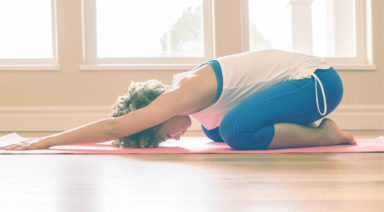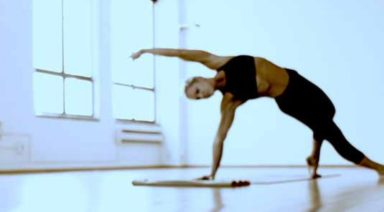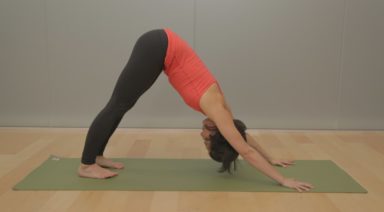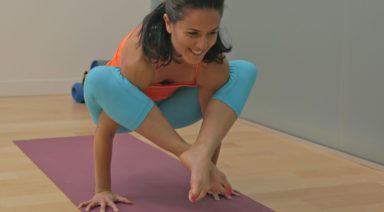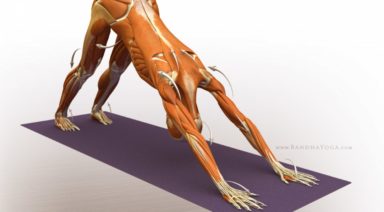Poor Posture and Pressure on your Spine

Freddie Mercury was right: we’re under pressure. Nothing can be truer when it comes to your spine. It’s because of simple physics: the pressure or load on your back increases as you move away from a neutral posture. Here are the numbers: Standing straight puts 100mm of pressure on the intervertebral discs of your spine; add a forward bend while flexing or rounding your back and you’ve more than double the pressure, or 220mm. Can you see now why reaching your toes in Uttanasana or any standing forward bend before you’re ready isn’t worth the potential harm to your back?
What poor posture means to the ongoing health of your back?
Over time, poor posture causes the discs between the vertebrae to wear down and lose their ability to cushion and act as shock absorbers. The discs are pushed out towards the back from their normal position which causes bulging or herniated discs. These bulging and worn out discs can cause a more serious problem by increasing the pressure on the spinal nerves and the spinal cord itself. The result is pain in the legs, including sciatica, arms, shoulders, and neck, and problems with muscle innervations, movement patterns and the sensation of temperature, pressure and pain.
These same problems can be worsened when sitting, believe it or not. Sitting, in contrast to standing, actually increases the intradiscal load compared to standing; spinal pressure “sits’ around 140mm pressure. If you slouch (I’m talking to you desk slouchers!), spinal pressure increases to 190mm; add some weight and you’ve put a whopping 275 pounds of pressure on your spine. This is why in certain methods of yoga like Iyengar students learn standing poses before sitting ones as a general rule as they’re considered more advanced.
Sitting for long periods of time can definitely cause back pain or worsen an existing back problem. Sitting is a static posture that increases stress on the entire back, shoulders, arms, and legs, and especially the muscles of the spine. Slouching overstretches spinal ligaments and surrounding structures of the spine and nerves, blood supply is interrupted and the back muscles are overstretched.
The Solution
If you’re not a yogi yet but find yourself slouching or sitting for long periods of time during the day, your yoga can be as simple as doing the following:
-
Getting up periodically to stand up and take the pressure off your spine
-
Sit back into your chair so your back is supported. In yoga postures, ground evenly into your support and allow your spine to straighten up
-
Use a lumbar roll between your lumbar or lower back and your chair. To judge the proper size of the roll, sit back in your chair, place your forearm behind your lower back between it and your chair and lean back. Your forearm is approximately the size of a lumbar roll. This works when driving too.
-
Move! Joints don’t have much blood flow. Joints get nutrition in and waste out by physical movement. Move freely in your chair instead of sitting still for hours at a time.
For you yogis, body awareness is key to minimizing the pressure on your back. I’m not saying never practice a forward bend or a seated pose but rather know how to practice them safely. Even a seemingly friendly pose like Savasana can do harm. Sure, while lying down you’re at the lowest end of the spinal load spectrum at 25mm. As a teacher, I ask my students to roll to the side before sitting up not simply to avoid feeling dizzy and lightheaded but also to reduce the pressures on the spine. For the record, resting on your side applies 75mm pressure on your back, which is quite a bit less than pulling yourself straight up from lying flat on your back.
So, the take home message is: do the work in other poses which don’t load the spine first to lengthen your leg muscles and hamstrings, and strengthen your back before you throw yourself into a forward bend. Realize which types of poses are right for you. Gentle flexion of the spine isn’t for everybody and that’s ok. Once your body is ready, you’ll be reaping the benefits of practicing Uttanasana instead of causing harm to our back.
Yoga Anatomy: Avoid Hand and Wrist Injuries

Think of the number of times your hands and wrists are connected to the earth and carry your weight in a typical Hatha Yoga practice. Like our feet, our hands frequently become a crucial foundation from which our postures build and express themselves. Sustaining mindful engagement of our hands will support a life-long practice that is free of negative stress conditions and injuries to the wrist. Let’s look at some anatomical aspects to give us empowerment and motivation to explore our unique positioning and engagement of the hands and wrists.
The wrists are formed by our 2 forearm bones (the radius and ulna). They meet dat the wrist joint where there is cluster of small bones (carpal bones). The carpal bones connect with 5 long bones (metacarpal bones) that make up the palm of the hand. From there, the metacarpal bones connect to the bones of the fingers (phalanges). The carpal bones form a tunnel through which tendons and nerve tissue pass to service the hand and fingers. One primary focus of hand engagement is to avoid collapsing into this tunnel and keeping excessive pressure from cascading into that track of muscle and nerve tissue.
One primary focus of hand engagement is to avoid collapsing into this tunnel and keeping excessive pressure from cascading into that track of muscle and nerve tissue.
Another key structural area to consider is the joint connection between the ulna and the carpal bones. If you turn your hand open (supination of the forearm and wrist), your ulna is the inside forearm bone (medial side). Unlike the radius (lateral or thumb side) that has a direct joint connection to the carpal bones, the ulna has indirect joint connection. Instead, there is a piece of fibrocartilage (designed to absorb stress forces) between the ulna and carpal bones along with a network of supporting ligaments – this area is called the Triangular Fibrocartilage Complex. When we look at the overall differences in joint connection, the radius also has a larger joint surface compared to the ulna. This gives indication that most people are best served to deliver a greater proportion of their force and energy through the radial side of the wrist than through the ulnar side.

















